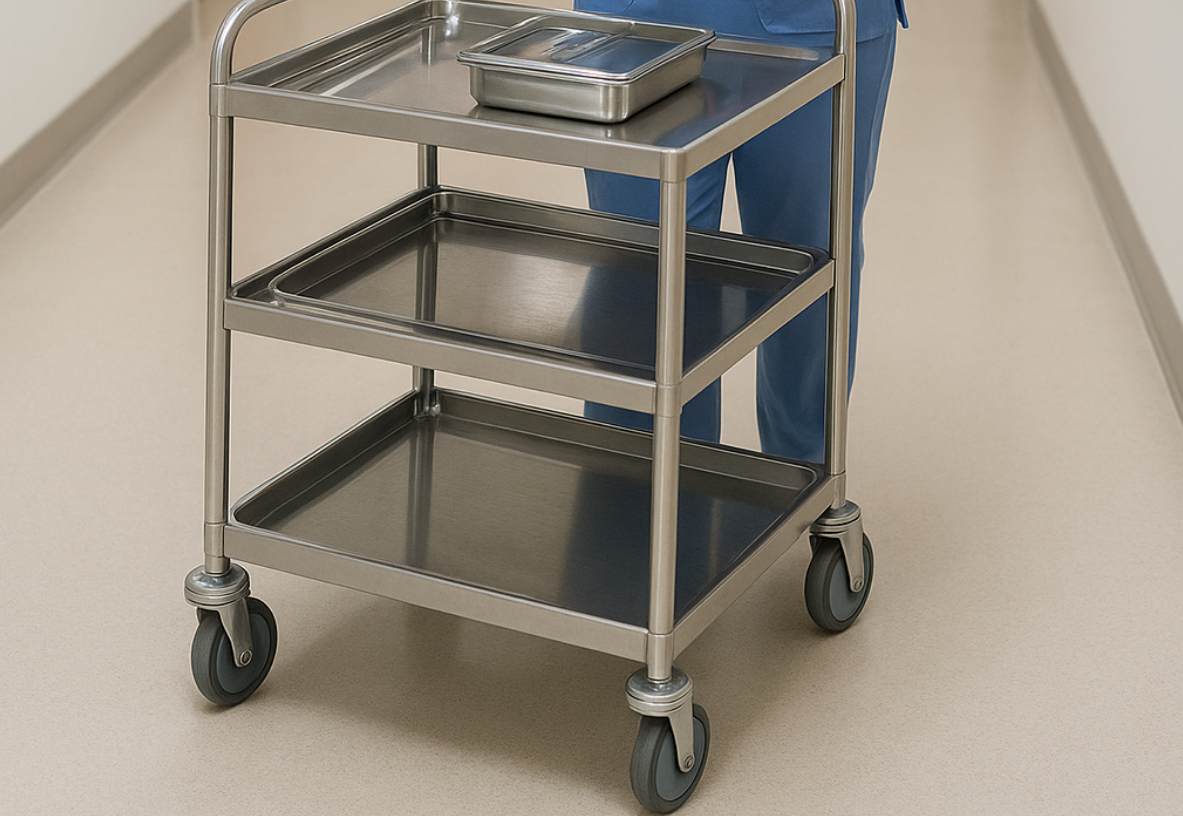Stainless steel is a cornerstone material in healthcare, trusted for its strength, durability, and resistance to corrosion. Whether it’s surgical instruments, carts, or medical furniture, the right type of stainless steel ensures safety, hygiene, and long-lasting performance. At Forsyth Healthcare, we know that choosing the best stainless steel for your medical equipment is crucial.
Here’s a comprehensive (and hopefully straightforward) guide to the most common types and what makes each one special for medical use.
Questions? As always, just reach out.
Why Stainless Steel Matters in Healthcare
Medical-grade stainless steel stands apart because it resists rust, withstands repeated sterilization, and is biocompatible when needed. This makes it perfect for environments demanding cleanliness and durability. But not all stainless steel is created equal — different grades have unique compositions and properties suited to various tasks.
Most Common Stainless Steel Types in Medical Use
1. Austenitic Stainless Steels: 304 and 316 Series
- 304 Stainless Steel: The workhorse of medical stainless steel, 304 offers excellent corrosion resistance and is chemically inert. It’s used widely in hospital furniture, sinks, carts, and many medical applications because it withstands sterilization processes without reacting.
- 316 Stainless Steel: Similar to 304 but with added molybdenum, 316 provides superior resistance to chlorides and harsh chemicals, making it ideal for implants and surgical instruments exposed to aggressive environments.
- Low Carbon Variants (304L, 316L): These versions have lower carbon content, which reduces the risk of carbide precipitation during welding, critical for maintaining corrosion resistance in welded medical devices.
2. Martensitic Stainless Steels: 420, 440, and 630 Series
- 420 Stainless Steel: Known for hardness and wear resistance, 420 is common in surgical tools like scalpels and cutters. It can be hardened for sharpness but offers moderate corrosion resistance.
- 440 Stainless Steel: Often called “razor blade steel,” 440 has very high hardness and sharpness, used for precision cutting instruments. The “C” variant has higher carbon content for greater strength.
- 630 Stainless Steel (17-4 PH): This precipitation-hardening grade combines strength and corrosion resistance, suitable for surgical instruments needing durability and toughness under use.
Specialty Attributes for Medical Stainless Steel
- Biocompatibility: Particularly with 316L, medical stainless steels can be safely used in implants, as they don’t react adversely with body tissues or fluids.
- Sterilization Resistance: 304 and 316 grades can withstand autoclaving and chemical sterilization without degradation, essential in hospitals and labs.
- Non-magnetic Properties: Critical for MRI-compatible equipment, stainless steels like 316L don’t interfere with sensitive imaging devices.
Applications of Stainless Steel in Healthcare Settings
- Surgical Instruments: Scalpel blades, forceps, clamps, and scissors rely on grades like 420 or 440 for sharpness and durability.
- Medical Furniture and Carts: 304 stainless steel is widespread in carts, shelving, and furniture, and is chosen for strength and ease of cleaning.
- Implants: 316L’s superior corrosion resistance and biocompatibility make it the go-to choice for internal implants and fixation devices.
- Specialty Equipment: Stainless steel with specific finishes or properties, like those resistant to staining or designed for easy sterilization, support operating room and cleanroom demands.
Choosing the Right Stainless Steel for Your Needs
Selecting the ideal stainless steel grade balances factors like environment, mechanical demands, sterilization methods, and cost. For example:
- Use 304 or 304L for general-purpose hospital equipment.
- Opt for 316 or 316L when chemical resistance and implant-grade quality are paramount.
- Choose 420 or 440 for precision cutting tools needing sharpness and wear resistance.
- Consider 630 (17-4 PH) for surgical instruments requiring both strength and corrosion resistance.
At Forsyth Healthcare, we’re dedicated to helping you navigate technical details that matter. The right stainless steel choice ensures your medical equipment performs reliably while meeting rigorous healthcare standards.
Got questions about stainless steel grades or how to optimize your healthcare carts and instruments? Reach out: we’re here to help you make the best, most informed decisions for patient safety and operational excellence.
Sources
Understanding Medical Grade Stainless Steel: Properties & Types — SteelPRO Group
Which Stainless Steel Grade Is Best for Medical Device Components? — Worthy Hardware
Surgical stainless steel — Wikipedia
What is surgical steel? The role of stainless in healthcare — Essentra Components
What Stainless Steel is used for Medical Instruments? — Lake Air Metals
Stainless Steel Flat Products in Medical Manufacturing — Source 21



